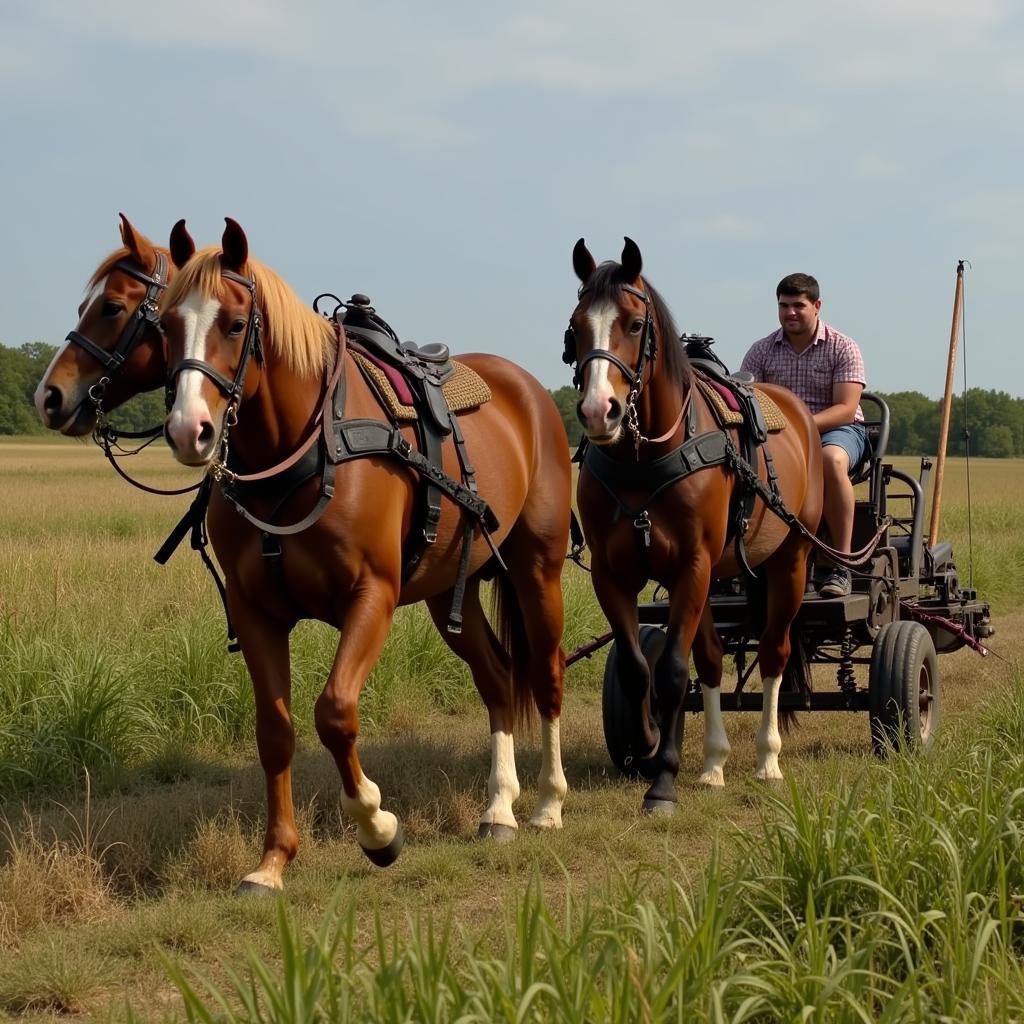A Horse Drawn Bush Hog offers a unique blend of traditional farming and effective land management. This time-tested method provides a sustainable and, for some, more enjoyable way to reclaim overgrown pastures and maintain your land. Whether you’re new to horse drawn equipment or a seasoned pro, understanding the nuances of a horse drawn bush hog can make all the difference in achieving a well-groomed and healthy field.
Harnessing the Power of the Past: Benefits of a Horse Drawn Bush Hog
In a world increasingly reliant on motorized equipment, the horse drawn bush hog stands out as a testament to simpler times and sustainable practices. Here are some key advantages of choosing this traditional method:
- Eco-Friendly Operation: Reduce your carbon footprint and minimize noise pollution by opting for horse power over engine power. This environmentally sound approach is gentler on your land and contributes to a healthier ecosystem.
- Cost-Effectiveness: Horse drawn bush hogs generally require lower initial investment and have lower operating costs compared to their motorized counterparts.
- Accessibility and Maneuverability: Their compact size and maneuverability make them ideal for navigating smaller properties, uneven terrain, and areas where larger equipment struggles to reach.
- The Joy of Traditional Farming: For many, working with horses provides a deeper connection to the land and a rewarding experience that modern machinery simply can’t replicate.
 Horse Drawn Bush Hog in Action
Horse Drawn Bush Hog in Action
Selecting the Right Horse Drawn Bush Hog for Your Needs
Choosing the right bush hog depends on several factors, including the size of your property, the density of vegetation, and your budget.
- Types of Horse Drawn Bush Hogs:
- Single-Wheel Bush Hogs: These are best suited for lighter-duty work and smaller areas. Their maneuverability makes them ideal for navigating obstacles.
- Double-Wheel Bush Hogs: Offering greater stability and cutting width, double-wheel models are better equipped for larger properties and denser vegetation.
- Cutting Width: Consider the width of the cutting deck as it directly impacts the efficiency of your work. Wider decks cover more ground in a single pass.
- Blade Type: Different blade types are designed for specific tasks. For general brush clearing, standard “swinging” blades are effective. For heavier-duty work or dealing with saplings, consider “shredder” blades.
Operating a Horse Drawn Bush Hog Safely and Effectively
Operating a horse drawn bush hog safely and effectively requires a blend of horsemanship skills, equipment knowledge, and careful planning.
- Teamwork Makes the Dream Work: Ensure your horses are well-trained and accustomed to working together. Proper communication and handling are crucial.
- Pre-Operation Inspection: Before each use, thoroughly inspect the bush hog for any signs of wear and tear. Check the blades, hitch points, and tire pressure (if applicable).
- Safe and Gradual Starts: When engaging the bush hog, begin at a slow and steady pace, allowing the horses to adjust to the weight and resistance.
- Maintaining Cutting Height: Adjust the cutting height to avoid scalping the ground, which can damage beneficial plants and encourage erosion.
- Regular Maintenance: Clean the bush hog after each use to prevent rust and build-up. Lubricate moving parts and sharpen or replace blades as needed.
Expert Insights: Tips from a Seasoned Horseman
“I’ve been using horse drawn equipment for over 20 years,” says experienced horseman, Johnathan Miller, “and I wouldn’t have it any other way. It’s not just about getting the job done; it’s about connecting with tradition and respecting the land. When operating a horse drawn bush hog, remember to prioritize safety, communicate clearly with your horses, and never underestimate the importance of regular maintenance.”
FAQs about Horse Drawn Bush Hogs
Q: How much horsepower do I need to operate a horse drawn bush hog?
A: A team of two draft horses is generally sufficient for most horse drawn bush hogs. However, the required horsepower can vary based on the size and weight of the bush hog, as well as the density of the vegetation.
Q: Can I use a horse drawn bush hog on slopes?
A: Operating on slopes requires extra caution and experienced horses. It’s generally advisable to avoid steep slopes altogether.
Q: How do I store my horse drawn bush hog?
A: Store your bush hog in a dry, sheltered area to protect it from the elements. Ensure the blades are disengaged and use jack stands for added stability.
Need Help with Your Land Management?
Contact Justus Horses USA at 0772127271 or email us at [email protected]. Visit us at QGM2+WX2, Vị Trung, Vị Thuỷ, Hậu Giang, Việt Nam. Our team of experts is available 24/7 to answer your questions and help you find the perfect horse drawn solutions for your needs.